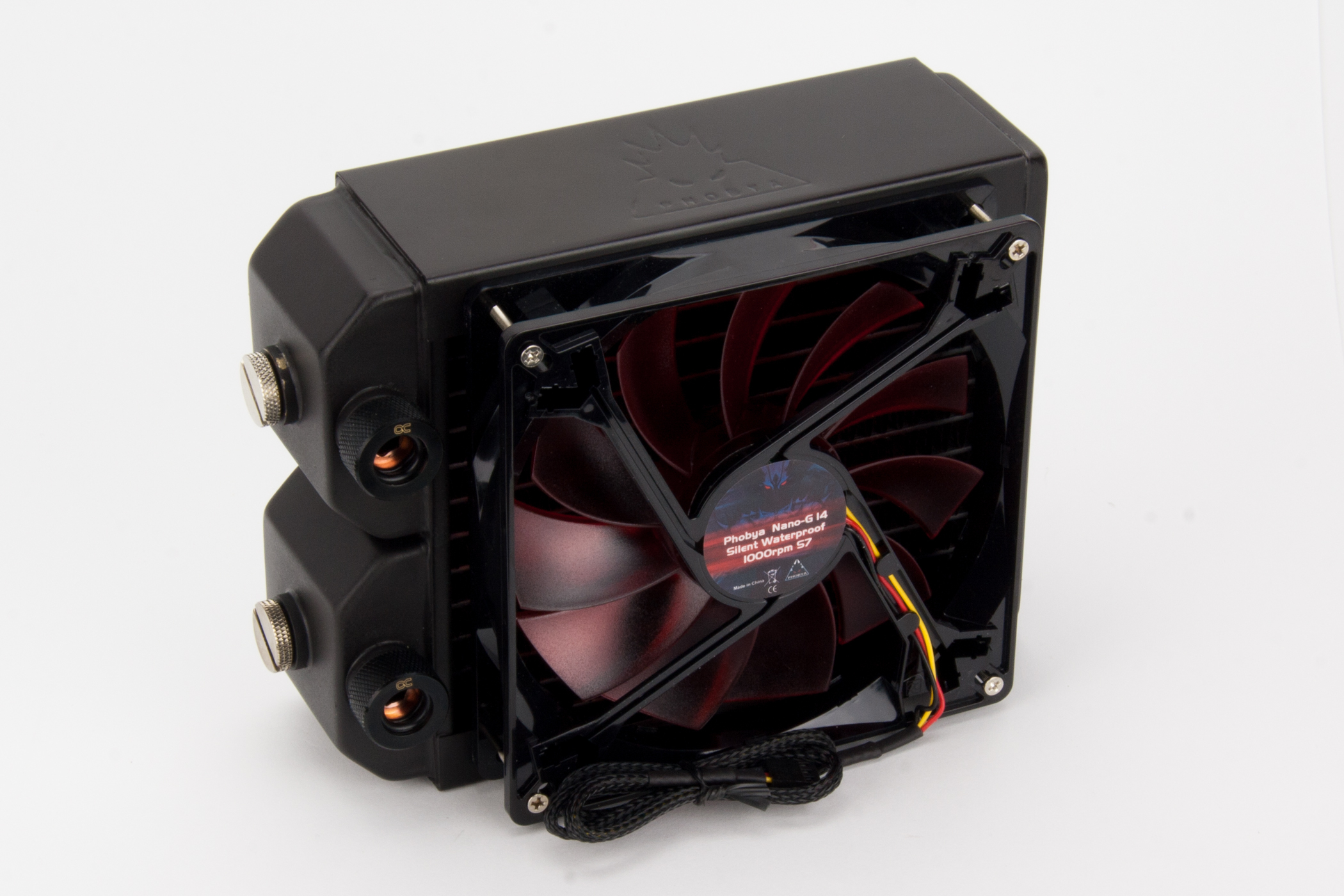This first table shows the G-Changer 140’s Watts/10 Delta Temp numbers in a quick glance chart format

Using this data we can effectively show percentage gains/losses relative to a reference point. It’s an interesting way to show gains/losses while changing a variable.
So, let’s focus on 1300 RPM as our reference and see how much gain or loss in performance we get by changing fan speed.
 As we noted earlier the performance gap is greater between 750 rpm and 1250 rpm than it is for the rpm increase from 1250 to 1850.
As we noted earlier the performance gap is greater between 750 rpm and 1250 rpm than it is for the rpm increase from 1250 to 1850.
So from the data above we have a good idea of how the G-C 140 radiator performs relative to itself in Push Only and Push/Pull at various fan speed, but there is a large selection of 140mm radiator models to choose from, released from numerous manufacturers.
As we have some other 140mm radiators with thermal testing complete, let’s put the Phobya G-Changers 140’s results into some charts with the other radiator’s data for some comparisons.
Push Only Data vs Competition
Let’s focus on the Push Only results for now and come back to the Push/Pull data later.
Starting with 750 RPM let’s see how the G-Changer performs comparatively.
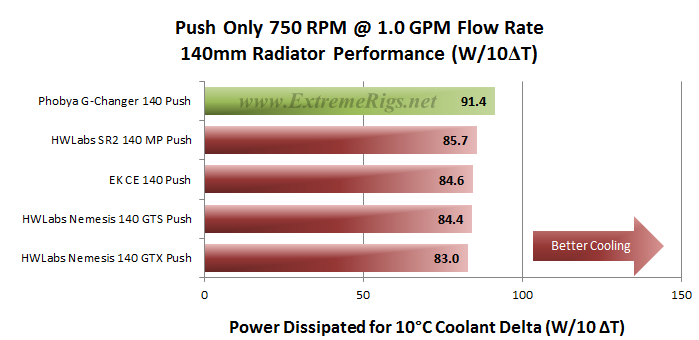 While we hesitate to make predictions this was not the data point where we expected the G-C 140 to have a an advantage, however it clearly was the best performer at this data point.
While we hesitate to make predictions this was not the data point where we expected the G-C 140 to have a an advantage, however it clearly was the best performer at this data point.
Now let’s look at 1300 rpm:
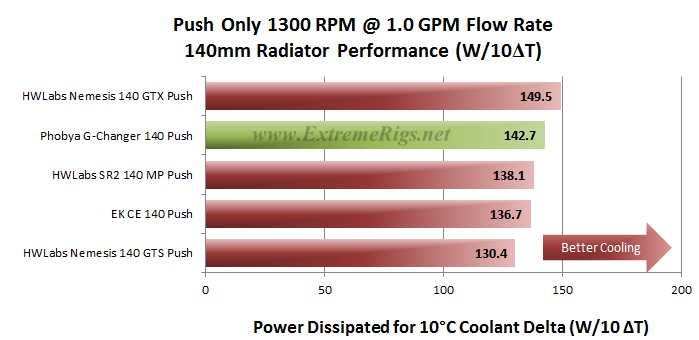
At 1300 rpm Push Only the Nemesis GTX which placed last at 750 rpm shoots out to take the lead. There is something about the Nemesis GTX rads where they perform poorly at low rpm at Push Only, we’ve seen it before and it annoys us every time as it just does fit the trend.
The G-Changer 140 placed 2nd and this was where we expected it to have it best comparisons.
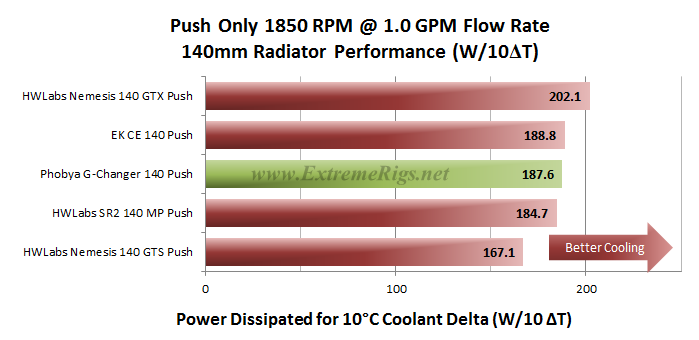 At 1850 rpm the G-C 140 finishes a close 3rd while the Nemesis GTX pulls further ahead of the competition.
At 1850 rpm the G-C 140 finishes a close 3rd while the Nemesis GTX pulls further ahead of the competition.
So it appears (somewhat unexpectedly) that the G-Changer 140 is well tuned for all fan speeds in Push Only having taken a 1st, 2nd and 3rd place in our tests. This is a fantastic result for the Phobya radiator We saw the results were trending down as air flow was increased, so can it keep up with the pack in the Push/Pull tests.
Let’s find out.
Push/Pull Data vs. Competition
Let’s now look at the Push/Pull results and see how the G-C 140 compares.
Again the 750 rpm first:
 Taking 3rd place ~6.5% behind the winning rad, the G-Changer 140 turns out a good result and isn’t too far from the leaders.
Taking 3rd place ~6.5% behind the winning rad, the G-Changer 140 turns out a good result and isn’t too far from the leaders.
Let’s move to 1300 rpm:
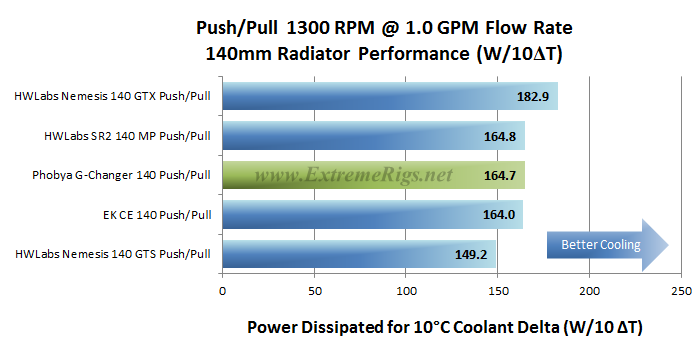
At 1300 rpm Push/Pull the Nemesis GTX has jumped head of the tightly grouped middle pack which includes the G-C 140.
Now 1850RPM:
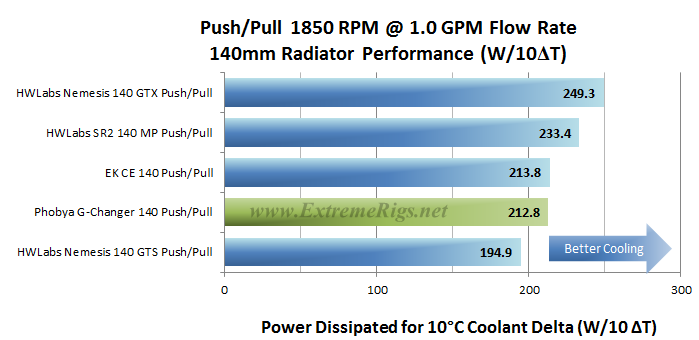 At 1850 rpm Push/Pull the G-Changer 140 has fallen further behind the leader.
At 1850 rpm Push/Pull the G-Changer 140 has fallen further behind the leader.
Let’s now combine the Push Only and Push/Pull results of our 1.0 GPM flow rate tests into one plot for each fan speed tested. Sometimes these combined plots show up some points of interest.
Again the 750 rpm first:
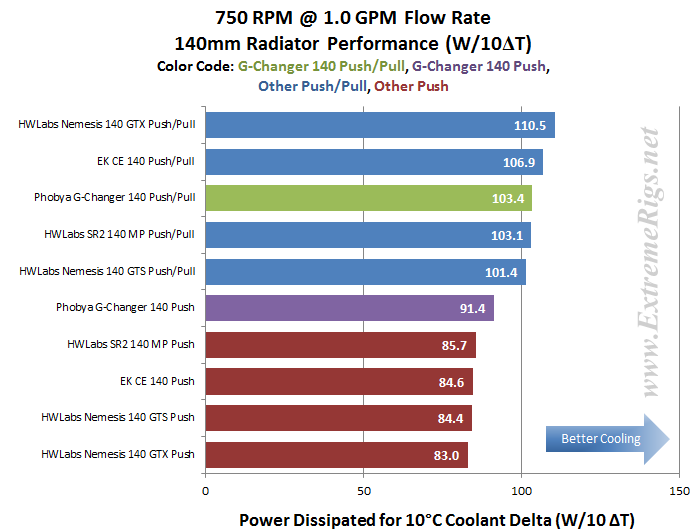
Nothing looks out of place here..
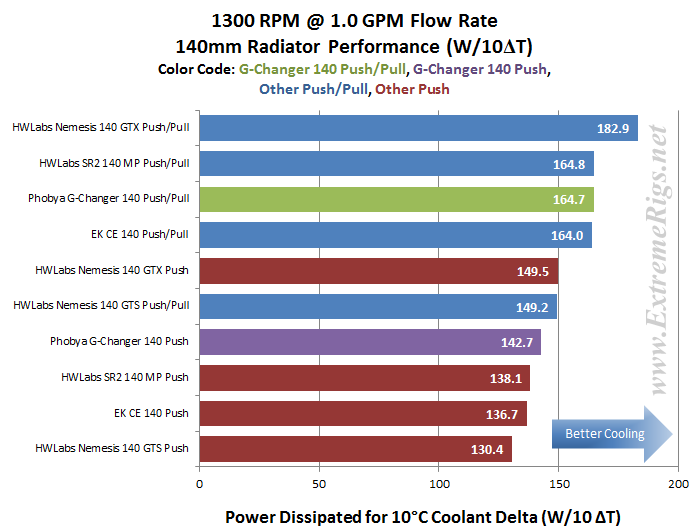
At 1300 rpm everything looks in order for the G-Changer given the data we’ve already reviewed. Of interest though is the Nemesis GTX Push Only beating is slimmer stable mate in Push/Pull!!
It was exactly the same with the 1850 combined.
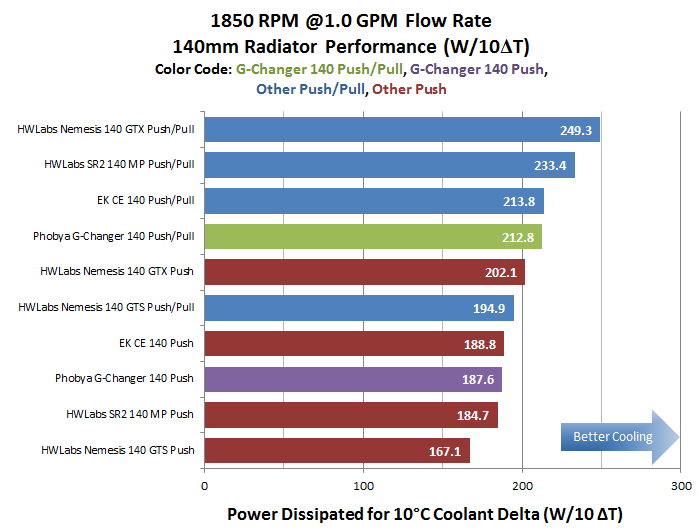
One last view before we move onto the summary, this time plotted as curves and adding some extrapolation.
Push Only first up:
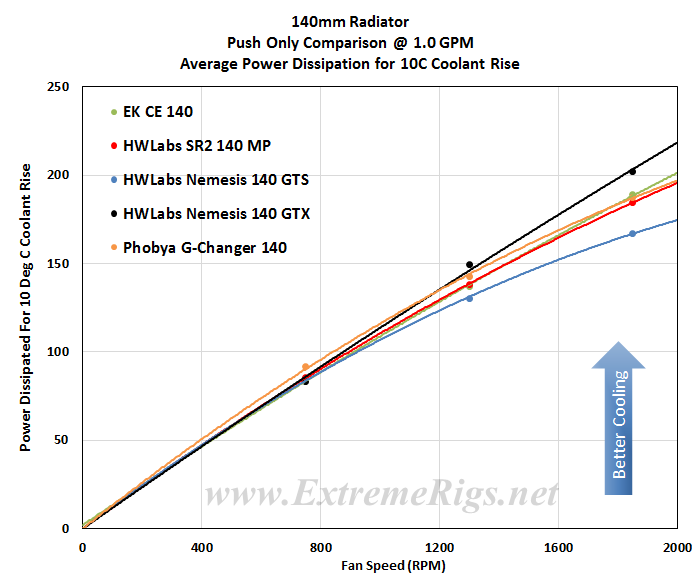 This plot perhaps best shows just how close the results are particularly at the low fan speeds.
This plot perhaps best shows just how close the results are particularly at the low fan speeds.
In the Push/Pull we see a bit more separation occurring as the different core designs show their strengths and weaknesses with the higher air flow.
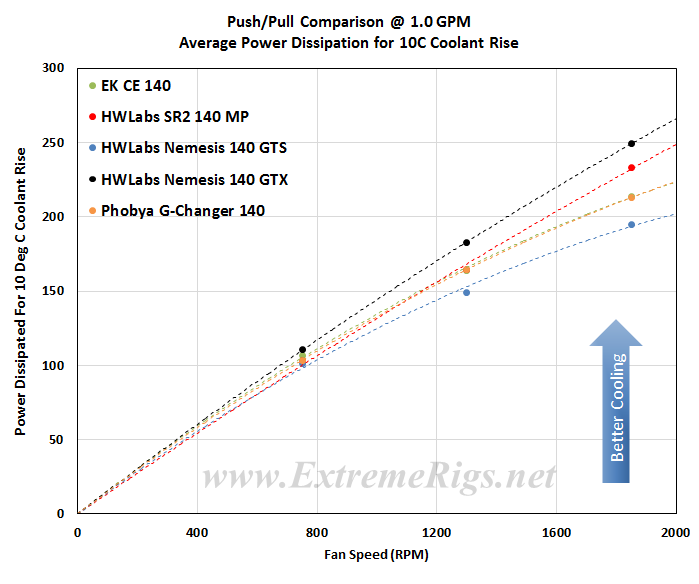 From all of test results we created “Average Performance Factor” charts for both Push and Push/Pull and then a combined plot called the “Master Performance Factor”. The radiator with the best cooling ability (W/10ΔT) at each rpm was awarded a score of 100, and each other radiators W/10ΔT result was scored as percentage of the top performer.
From all of test results we created “Average Performance Factor” charts for both Push and Push/Pull and then a combined plot called the “Master Performance Factor”. The radiator with the best cooling ability (W/10ΔT) at each rpm was awarded a score of 100, and each other radiators W/10ΔT result was scored as percentage of the top performer.
This way of looking at the comparison takes away any advantages that a radiator may have at higher or lower fan speeds and looks at an overall average. While this appears fair it does tend to favor those radiators that are all-rounders and those radiators which do very well at high RPM. Most users should be more focused on their specific use case.
Here is the G-Changer 140’s percentage scores at each data point that thermal tests were conducted at with the addition of the it’s Push Only results relative to the Best performing Push/Pull results
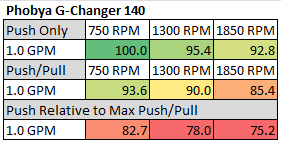
This can give a false impression that the G-Changer performed poorly as the air flow was increased, when it is probably more accurate to say that another radiator’s performance improved as the air flow increased.
The percentage numbers in the table offer another way of looking at the G-Changer’s results comparatively and how it performed, but for our scoring system we need a way to reduce the categories while retaining the data. To do this we average the results for each fan assembly type giving us Averaged Performance Factors for Push Only, Push/Pull and finally an average of everything in the Master Averaged Performance Factor.
Firstly – the Push Only APF:
 The G-Changer’s excellent results at all fan speeds meant it achieved a Push Only APF score to 96.1, less than 1% behind the winner.
The G-Changer’s excellent results at all fan speeds meant it achieved a Push Only APF score to 96.1, less than 1% behind the winner.
Now the Push/Pull APF:
 The G-Changer did not perform terribly in Push/Pull, but other radiators were better tuned for it. Scores were very close in the middle-pack but the G-Changer was edged out to 4th place. The Nemesis GTX dominated taking 1st place at all 3 fan speeds.
The G-Changer did not perform terribly in Push/Pull, but other radiators were better tuned for it. Scores were very close in the middle-pack but the G-Changer was edged out to 4th place. The Nemesis GTX dominated taking 1st place at all 3 fan speeds.
Finally we created the Master Performance Factor which is calculated from the averaged results of all the Push Only and Push/Pull thermal tests, at all fan speeds.
 Overall the Phobya G-Changer 140 takes second place in our thermal tests. The excellent Push Only results helped boost the overall score to 92.9 which was 5.5% behind the winner.
Overall the Phobya G-Changer 140 takes second place in our thermal tests. The excellent Push Only results helped boost the overall score to 92.9 which was 5.5% behind the winner.
Next up – Summary!







